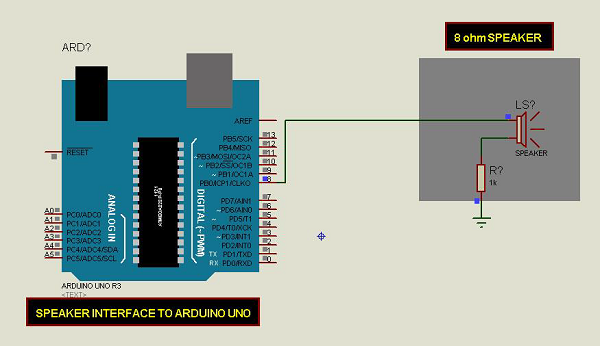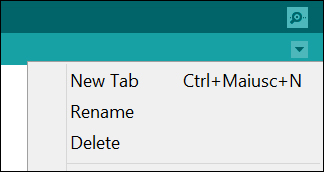Arduino - Biblioteca de tons
Neste capítulo, usaremos a Biblioteca de tons do Arduino. Não é nada além de uma biblioteca Arduino, que produz ondas quadradas de uma frequência especificada (e ciclo de trabalho de 50%) em qualquer pino Arduino. Uma duração pode ser especificada opcionalmente, caso contrário, a onda continua até que a função stop () seja chamada. O pino pode ser conectado a uma campainha piezoelétrica ou um alto-falante para reproduzir os tons.
Warning- Não conecte o pino diretamente a nenhuma entrada de áudio. A tensão é consideravelmente mais alta do que as tensões de nível de linha padrão e pode danificar as entradas da placa de som, etc. Você pode usar um divisor de tensão para reduzir a tensão.
Componentes necessários
Você precisará dos seguintes componentes -
- 1 × alto-falante de 8 ohms
- 1 × 1k resistor
- 1 × placa Arduino UNO
Procedimento
Siga o diagrama do circuito e faça as conexões conforme mostrado na imagem abaixo.

Esboço
Abra o software Arduino IDE em seu computador. A codificação na linguagem Arduino controlará seu circuito. Abra um novo arquivo de esboço clicando em Novo.

Para fazer o arquivo pitches.h, clique no botão logo abaixo do ícone do monitor serial e escolha "Nova Aba", ou use Ctrl + Shift + N.

Em seguida, cole o seguinte código -
/*************************************************
* Public Constants
*************************************************/
#define NOTE_B0 31
#define NOTE_C1 33
#define NOTE_CS1 35
#define NOTE_D1 37
#define NOTE_DS1 39
#define NOTE_E1 41
#define NOTE_F1 44
#define NOTE_FS1 46
#define NOTE_G1 49
#define NOTE_GS1 52
#define NOTE_A1 55
#define NOTE_AS1 58
#define NOTE_B1 62
#define NOTE_C2 65
#define NOTE_CS2 69
#define NOTE_D2 73
#define NOTE_DS2 78
#define NOTE_E2 82
#define NOTE_F2 87
#define NOTE_FS2 93
#define NOTE_G2 98
#define NOTE_GS2 104
#define NOTE_A2 110
#define NOTE_AS2 117
#define NOTE_B2 123
#define NOTE_C3 131
#define NOTE_CS3 139
#define NOTE_D3 147
#define NOTE_DS3 156
#define NOTE_E3 165
#define NOTE_F3 175
#define NOTE_FS3 185
#define NOTE_G3 196
#define NOTE_GS3 208
#define NOTE_A3 220
#define NOTE_AS3 233
#define NOTE_B3 247
#define NOTE_C4 262
#define NOTE_CS4 277
#define NOTE_D4 294
#define NOTE_DS4 311
#define NOTE_E4 330
#define NOTE_F4 349
#define NOTE_FS4 370
#define NOTE_G4 392
#define NOTE_GS4 415
#define NOTE_A4 440
#define NOTE_AS4 466
#define NOTE_B4 494
#define NOTE_C5 523
#define NOTE_CS5 554
#define NOTE_D5 587
#define NOTE_DS5 622
#define NOTE_E5 659
#define NOTE_F5 698
#define NOTE_FS5 740
#define NOTE_G5 784
#define NOTE_GS5 831
#define NOTE_A5 880
#define NOTE_AS5 932
#define NOTE_B5 988
#define NOTE_C6 1047
#define NOTE_CS6 1109
#define NOTE_D6 1175
#define NOTE_DS6 1245
#define NOTE_E6 1319
#define NOTE_F6 1397
#define NOTE_FS6 1480
#define NOTE_G6 1568
#define NOTE_GS6 1661
#define NOTE_A6 1760
#define NOTE_AS6 1865
#define NOTE_B6 1976
#define NOTE_C7 2093
#define NOTE_CS7 2217
#define NOTE_D7 2349
#define NOTE_DS7 2489
#define NOTE_E7 2637
#define NOTE_F7 2794
#define NOTE_FS7 2960
#define NOTE_G7 3136
#define NOTE_GS7 3322
#define NOTE_A7 3520
#define NOTE_AS7 3729
#define NOTE_B7 3951
#define NOTE_C8 4186
#define NOTE_CS8 4435
#define NOTE_D8 4699
#define NOTE_DS8 4978Salve o código fornecido acima como pitches.h
Código Arduino
#include "pitches.h"
// notes in the melody:
int melody[] = {
NOTE_C4, NOTE_G3,NOTE_G3, NOTE_GS3, NOTE_G3,0, NOTE_B3, NOTE_C4};
// note durations: 4 = quarter note, 8 = eighth note, etc.:
int noteDurations[] = {
4, 8, 8, 4,4,4,4,4
};
void setup() {
// iterate over the notes of the melody:
for (int thisNote = 0; thisNote < 8; thisNote++) {
// to calculate the note duration, take one second
// divided by the note type.
//e.g. quarter note = 1000 / 4, eighth note = 1000/8, etc.
int noteDuration = 1000/noteDurations[thisNote];
tone(8, melody[thisNote],noteDuration);
//pause for the note's duration plus 30 ms:
delay(noteDuration +30);
}
}
void loop() {
// no need to repeat the melody.
}Código a ser anotado
O código usa um arquivo extra, pitches.h. Este arquivo contém todos os valores de pitch para notas típicas. Por exemplo, NOTE_C4 é o C. NOTE_FS4 é F sustenido e assim por diante. Esta tabela de notas foi originalmente escrita por Brett Hagman, em cujo trabalho o comando tone () foi baseado. Você pode achar útil sempre que quiser fazer notas musicais.
Resultado
Você ouvirá as notas musicais salvas nos pitches.h. Arquivo.